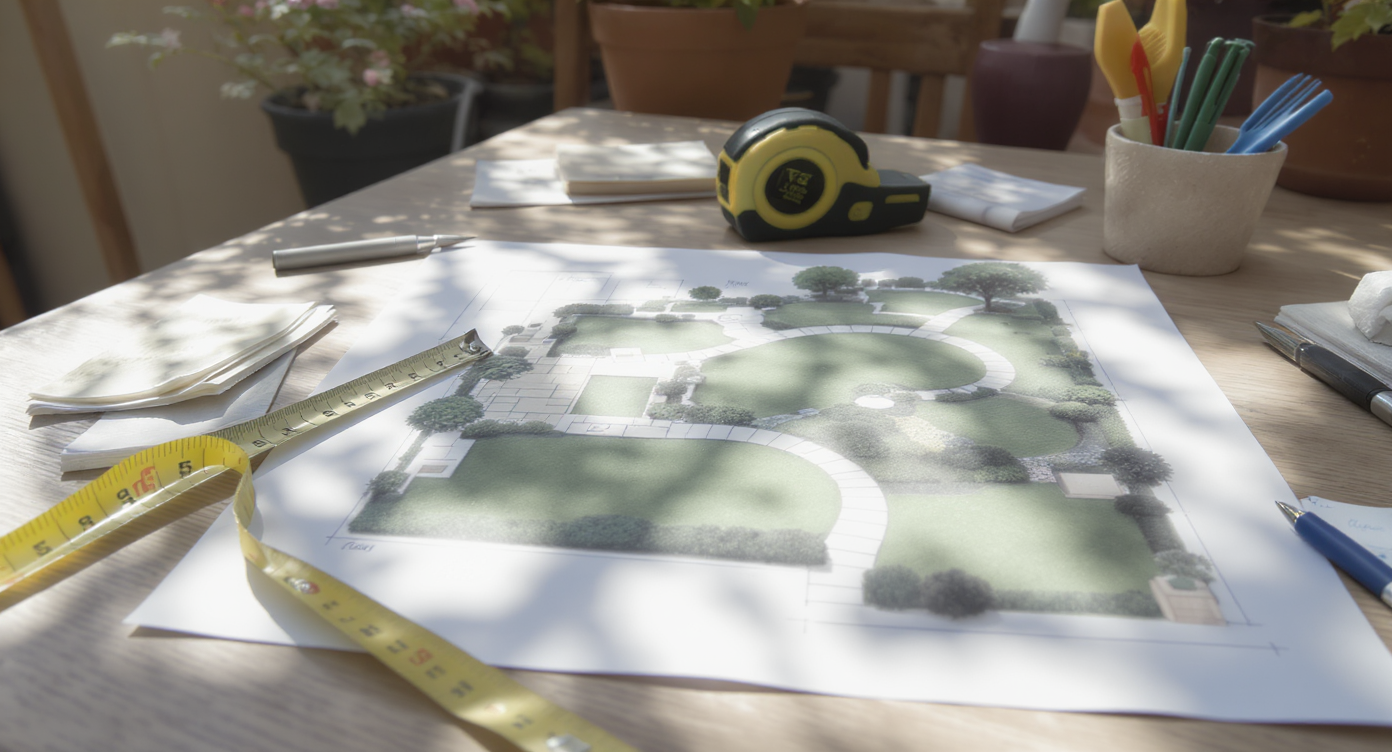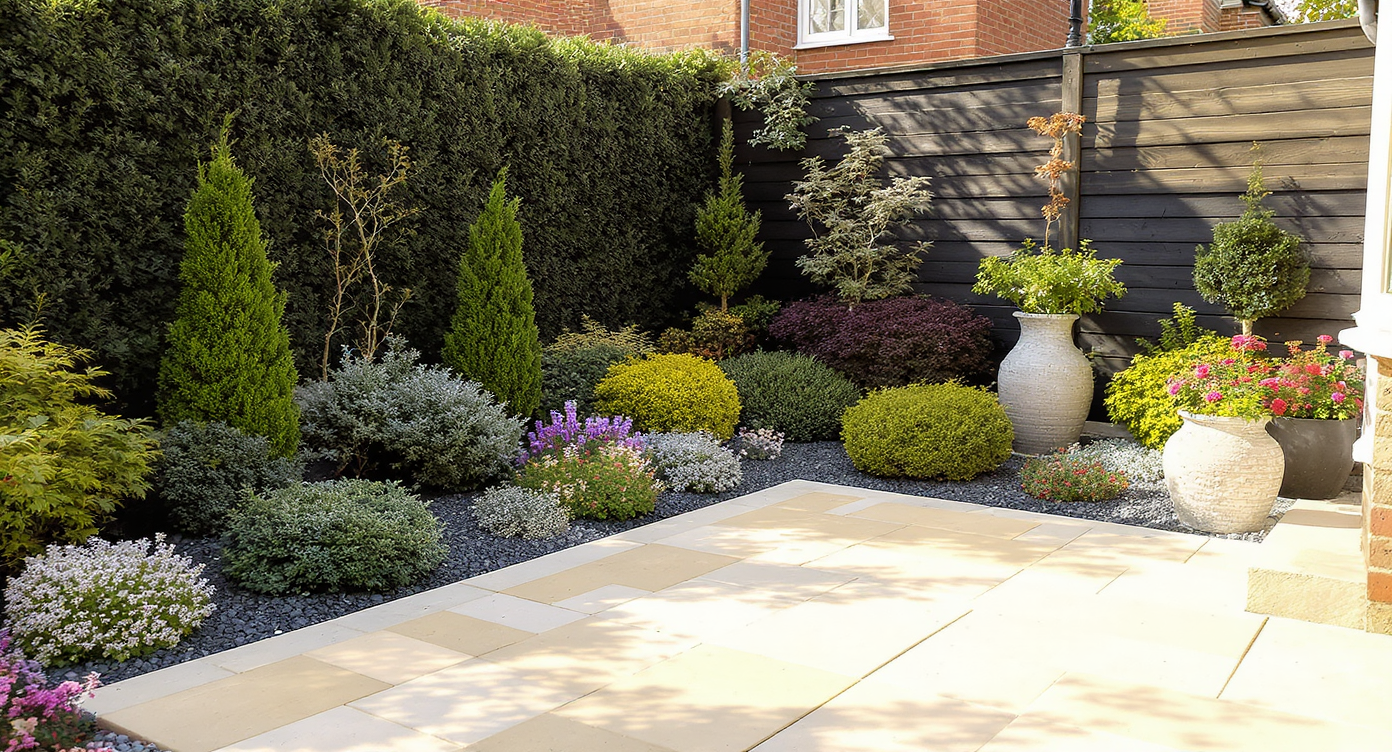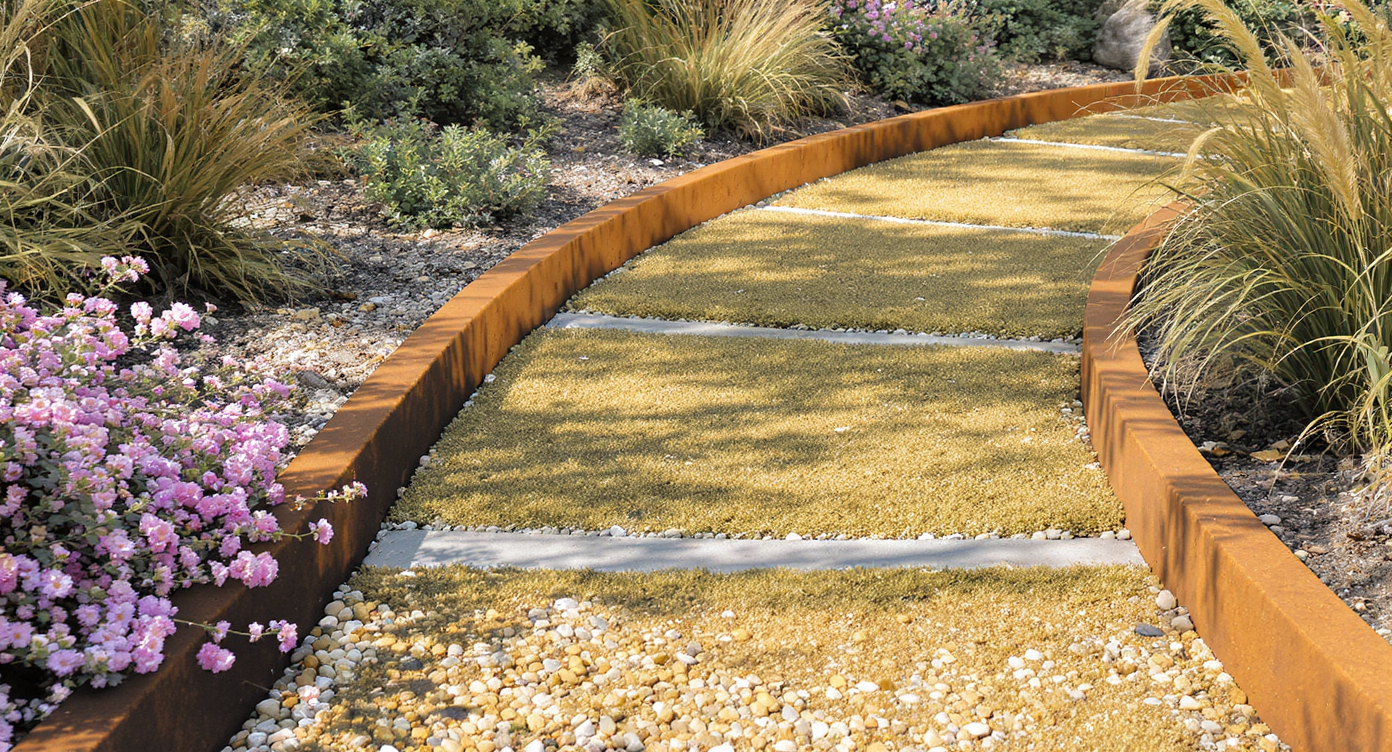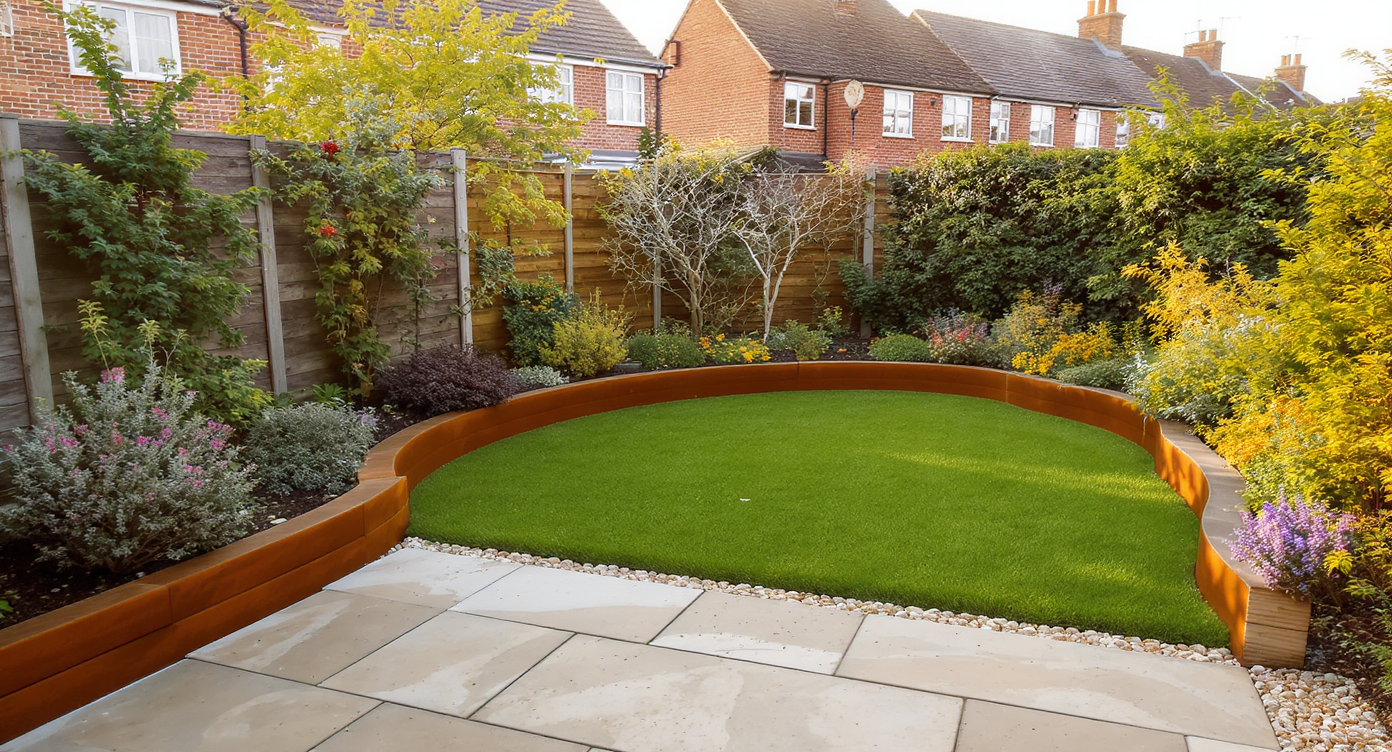TL;DR
You can landscape a small UK garden for roughly £2,500–£3,500 by pairing one solid patio, a curved path, and a compact lawn. This guide shows how to plan a budget Indian sandstone patio, form sleeper steps, and edge a curved path, including planting ideas and maintenance tips for a low‑effort, high‑impact space. If you’ve wondered how to landscape a small UK garden on a budget, start here.
Introduction

Planning smartly for a small garden helps align budget, space, and design goals before building begins.
Small back gardens gain the most from one strong patio, a simple lawn, and a clear path, even on a £3,000 budget. In compact plots, every slab, sleeper, and shrub has a job: to make daily life outside easier and more beautiful.
I’ve walked plenty of modest UK gardens where owners did the graft themselves. The winners share a simple pattern, patio at the sunniest end, a micro lawn for softness underfoot, and a curved route that turns a short walk into a small journey. The work is physical, but the design isn’t complicated. Think smart sub‑bases, sensible slopes, and materials that forgive beginners.
In one terrace garden, a father mixed mortar while his son laid sandstone; their pace nearly doubled compared with solo days. Another homeowner used 1‑metre lengths of flexible corten edging to sketch a serpentine path in an afternoon. The lesson, plan clearly, then build steadily.
Theme Overview

Combining hardscaping with contrasting planting enlarges small gardens visually and adds tactile interest.
Most small gardens look larger when you combine hardscaping with planting contrast, one crisp patio, one curving path, and one green anchor. The theme is utility wrapped in charm. From an Indian sandstone patio to sleeper steps, and from a micro lawn to pollinator‑friendly borders, you create a backyard design that feels finished, affordable, and easy to keep.
Here’s why that matters. A single, well‑laid patio handles dining, containers, and a fire bowl. A curved path adds motion and a place to pause. A small square of turf, or microclover if you prefer, offers cool relief in heat and keeps the garden from feeling like a car park. Layer in low‑maintenance plants, and you have a native‑leaning, eco‑friendly yard with real curb appeal.
Anecdote
In a Leeds terrace, a father handled the mixer while his son laid slabs; their output nearly doubled after the first course, proof that pairing up beats pushing on alone.
Ideas, Tips and Designs

The curved corten steel path adds dynamic flow and modern warmth to small garden layouts on a budget.
01. The Curved Corten Path
A 300–450 mm wide path with a 50–75 mm compacted sub‑base is sufficient for foot traffic in small gardens.
What it is: A sinuous walkway defined by flexible steel edging that turns a short garden into a gentle journey.
How it works: Flexible corten steel edging often comes in 1 metre sections that interlock, so you can hand‑curve a smooth line without special tools. Set the edging on compacted Type 1, then fill with self‑binding gravel, 10 mm gravel, or clay‑bound hoggin. Keep the path about 10–15 mm above adjacent soil to shed water and maintain a fall of roughly 1:80 from house to boundary. Field note, in a Bristol courtyard, one afternoon and six lengths of edging were enough to create a tidy S‑curve that visually doubled the depth of the plot.
- Mark the curve with a hose, then paint the line for accuracy.
- Use 75–100 mm of compacted Type 1 under traffic zones.
- Rake and roll the surface, topping up fines after the first heavy rain.
02. A DIY Indian Sandstone Patio
A 75–100 mm compacted Type 1 sub‑base with a 30–40 mm full‑bed mortar supports most sandstone patios on stable ground.
What it is: A warm, durable terrace, often in mixed sizes, that brightens small spaces and resists UK weather.
How it works: Excavate to reach the right finished height, at least 150 mm below the damp‑proof course at the house, and build in a fall around 1:60 away from the property. Compact Type 1 in two passes, then lay slabs on full beds of 4:1 mortar after slurry‑priming the backs for adhesion. Space joints 8–10 mm and clean as you go with a damp sponge. Production tip, two people, one mixing and one laying, can place 20–30 slabs per day, whereas solo pacing often halves that. Many designers prefer lighter hues to amplify light in narrow yards.
- Set string lines and levels before your first mix.
- Butter slab backs with primer to reduce lifting and staining.
- Use exterior jointing compound once the bed has cured.
03. Sleeper Steps and Raised Beds
Softwood sleepers of 100 x 200 mm fixed to stakes at 600–1200 mm intervals create sturdy risers for steps and low retaining beds.
What it is: Timber risers and planters that add structure, tame slopes, and bring planting right to eye level.
How it works: For steps, bed sleepers on compacted Type 1, pin them with stakes or bolt to posts set in postcrete, then infill between risers with hardcore and lay 450 x 450 mm stone treads on mortar. For raised beds, keep timber 50–75 mm off fences for airflow and maintenance, and use landscape screws to stitch corners. Field note, one homeowner reused old bricks between risers to save cost, topping with mortar and slab treads for a tidy finish.
- Pre‑drill and use 150–200 mm landscaping screws for clean joins.
- Add a damp‑proof membrane to inner faces to extend sleeper life.
- Cap with stone or leave a 5 mm drip gap to shed water.
04. The Tiny Lawn That Actually Works
New turf should be kept at 25–40 mm height and first mowed after 2–3 weeks, when it resists a gentle tug test.
What it is: A micro patch of real grass, two to four metres across, that cools the space and softens all the stonework.
How it works: Orient the lawn to catch at least four hours of sun for strong growth. Water deeply, roughly 10–15 litres per m² twice weekly in dry spells during establishment. Choose a 30–34 cm deck battery mower for easy storage, or switch to microclover for lower feed and less mowing. Anecdote, I’ve seen families rotate a guinea‑pig run across tiny lawns in summer, a surprisingly effective, if whimsical, mowing strategy.
- Edge with steel or stone to stop spread into beds.
- Top‑dress with 5–8 mm sand‑loam mix in spring to smooth seams.
- Consider microclover at 5–10 g/m² to reduce fertilizer needs.
05. A Rose‑Covered Arch for Privacy
A 1.2–1.5 m wide arch with two climbers can frame a path and screen a patio within two to three seasons.
What it is: A light structure at the path‑to‑patio threshold that creates a moment, filters views, and scents the air.
How it works: Set posts 450–600 mm deep in concrete, align the arch with your primary sightline, and plant one climber each side, spacing 45–60 cm off the uprights. Train laterals horizontally to encourage flower spurs. Fragrant roses, clematis, or star jasmine in warm spots bring romance and the sense of arrival.
- Choose repeat‑flowering roses for longer displays.
- Mulch 50 mm each spring to conserve moisture and feed soil life.
- Prune in late winter, tying new canes to arch ribs.
06. Low‑Maintenance Plants for Small Patios
Most sun‑loving perennials need 6 hours of direct light and 30–45 cm spacing for healthy airflow and easy care.
What it is: A compact palette that thrives in heat, wind, and weekend‑only attention.
How it works: Mix evergreen structure with long‑blooming perennials and grasses. Try lavender, Nepeta, Echinacea, and Salvia for pollinators, with Hebe or Pittosporum ‘Tom Thumb’ for year‑round form and Stipa tenuissima for movement. In containers, use 35–45 cm pots with free‑draining compost and water‑retaining granules. Garden designers often cluster plants in groups of three for bigger visual hits in small spaces.
- Group by water need, drought‑tolerant together, thirsty together.
- Use a single mulch color to visually unify borders.
- Deadhead weekly in peak bloom to extend the show.
07. Drainage and Slope Basics
A patio fall of 1:60 away from buildings, with finished surface 150 mm below the damp‑proof course, protects walls from splashback.
What it is: Subtle shaping that keeps water out of the house and off the paving.
How it works: Establish levels with a laser or tight string lines before excavation. If a door threshold is low, integrate a linear drain. Permeable path surfaces reduce runoff, and a gravel strip along fences prevents rot and gives you a discreet maintenance corridor.
- Check levels twice before laying the first slab.
- Add a 100–150 mm gravel margin along timber and boundaries.
- Keep bedding consistent to avoid rocking slabs and trip points.
08. The Two‑Person Laying Method
With one person mixing and one laying, many DIYers place 20–30 sandstone slabs per day versus 10–15 solo.
What it is: A simple division of labor that turns heavy work into efficient progress.
How it works: The mixer measures and feeds consistent 4:1 mortar to the layer, who focuses on full‑bed coverage, levels, and clean joints. Keep a soft brush, bucket, and sponge to wipe spills before they stain. Experts recommend priming slurry for sandstone to improve bond and reduce future lift. In my notes from a Leeds project, the pair gained speed after the first course, working to string lines and checking every third slab with a long level.
- Batch small, repeatable mixes to keep consistency high.
- Use a rubber mallet and a straightedge, not a hammer, for levels.
- Clean as you go; dried mortar haze is harder to remove later.
Transitional Reflection

Small garden elements together create a calm, generous outdoor space that feels larger than it is.
Every element here is small by design, yet together they feel generous and calm. The beauty of modern gardening isn’t perfection, it’s participation.
Build the bones once, then let the planting soften, scent, and sing through the seasons. Even a £3,000 makeover can change how a home is lived in, morning coffee on warm stone, bare feet on cool grass, and a path that curves just enough to make you slow down.
How to Visualize It

Visualizing your garden layout beforehand helps avoid costly mistakes and guides steady progress on site.
Seeing a layout before you dig reduces costly changes and wasted materials by an order of magnitude. Before you plant a single seed, map your space virtually, platforms like ReimagineHome let you preview garden layouts, sunlight paths, and color palettes, transforming sketches into living blueprints.
Use it to test patio sizes, path curves, and where to tuck that rose arch. Drop in furniture to confirm circulation, then switch paving tones to see how color affects brightness.
Alt text suggestion for visuals: Curved corten steel edging guiding a pale sandstone path to a sunny patio with a tiny central lawn and sleeper beds.
Visualization Scenario
A 5 x 8 m garden with a 3.6 x 3 m sandstone patio at the back, a 2.5 x 2 m central lawn, and a curved corten‑edged path threading from the door through sleeper beds to the terrace.
FAQ
Most patio projects in small UK gardens use 75–100 mm Type 1 sub‑base and a 1:60 fall away from the house for reliable drainage.
How do you landscape a small UK garden on a £3,000 budget?
Focus spend on one patio, a curved path, and a small lawn, reuse sound materials, and do the labour yourself. Many achieve it by prioritizing hardscape first, plants second.
What depth of sub‑base is best for an Indian sandstone patio?
On stable ground, 75–100 mm of compacted Type 1 under a 30–40 mm mortar bed is typical. Increase depth on soft or poorly drained soils.
How do you edge a curved garden path cleanly?
Use flexible steel edging in 1 m interlocking lengths pinned to a compacted base. Fill with self‑binding gravel or hoggin and roll for a firm surface.
When should new turf be mowed the first time?
After 2–3 weeks in growing weather, when it resists a gentle tug and reaches 30–40 mm height. Use a sharp blade and only take one‑third off.
What are the best low‑maintenance plants for small patios?
Sun lovers like lavender, Nepeta, Salvia, and grasses such as Stipa suit small, hot spaces. Add compact evergreens for year‑round structure.
Are sleepers OK right against a fence?
It is better to leave a 50–75 mm gap for airflow and access. A gravel strip in this gap improves drainage and reduces rot risk.
Closing Reflection
Most small gardens don’t need more stuff; they need clearer lines and kinder materials. A single terrace, a modest lawn, and a planted edge can hold a whole summer of living. I’ve watched first‑time DIYers lay their last slab at dusk, sponge in hand, grinning at a space that finally fits them. That’s the quiet victory of backyard design, it is less about budget and more about belonging.
If you’re ready to sketch your own version of this, try a virtual mock‑up with ReimagineHome, then pick a weekend, a mixer, and a friend. The garden will meet you halfway.
.svg)

.svg)










.png)